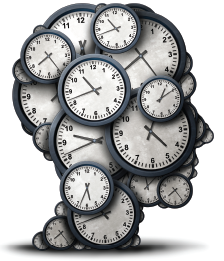
Medical schools train physicians not to complain about working long hours or stressful situations because it’s a sign of weakness, but burnout is real and must be managed.
Lightspring/shutterstock.com
Years ago, the Mayo Clinic was exploring effective ways to minimize burnout among the more than 3,000 doctors employed at its three medical and research facilities in Rochester, Minn., Scottsdale, Ariz., and Jacksonville, Fla. One strategy involved inviting physicians to participate in small groups to discuss topics that were fairly ubiquitous among doctors, from medical errors to work–life balance.
“The results were striking,” says Colin West, MD, PhD, professor of medicine at Mayo’s Rochester campus and co-director of the facility’s physician well-being program. “It was a randomized trial. The group involved in these discussions had markedly lower rates of burnout and markedly increased levels of sense of meaning from their work as physicians.”
As an occupational hazard, physician burnout is real, pervasive and potentially dangerous to doctors and their patients. For years, numerous studies have revealed the alarming effects or consequences of burnout—both personally and professionally—which has prompted some in the healthcare community to get off the sidelines and seek intervention strategies. So far, their efforts have been successful, providing dedicated physicians with opportunities to rebuild their strength or energy, regain their confidence as skilled clinicians and rediscover their purpose as medical practitioners.
One recent study—the Medscape Rheumatology Lifestyle Report 2016: Bias and Burnout—surveyed 15,800 physicians from more than 25 specialties. Although more than half (55%) of physicians in critical care, urology and emergency medicine reported the highest rate of burnout, rheumatologists fell toward the middle at 47%. More female rheumatologists (61%) experienced burnout than their male peers (40%). Overall, burnout among rheumatologists has slightly increased between 2013 and 2016 among men (from 33% to 40%) and women (from 59% to 61%).
Institutional Effort
Back at Mayo, more than 1,300 physicians and research scientists across all three campuses have voluntarily participated in informal group meetings since they were introduced in October 2015. The rules are simple:
- Form groups of six to 10 members;
- Meet roughly every other week for one hour whenever and wherever you want for six months; and
- Chat for at least the first 15 minutes of each meeting on one or more of three designated topics provided by Dr. West and his research team, such as why you chose to become a physician or when you might have contributed to a poor patient outcome.
In exchange, Mayo reimburses each doctor up to $20 for meals or other expenses they may incur during the meetings.
Six months after the program’s launch, Dr. West says program survey results revealed that approximately 95% of participants, who include rheumatologists, believed the meetings were valuable. So much so that after six months, many signed up again to meet with a different group.
He suspects the reasons why the remaining physicians and research scientists don’t participate may be due to difficulty in finding time to meet, or perhaps, they prefer to keep their personal lives private. Either way, he says, medical schools train physicians not to complain about working long hours or stressful situations because it’s a sign of weakness.
“We have learned that issues of physician burnout are really rooted in our medical systems and organizations,” says Dr. West, adding that the menu for solutions to burnout has to be diverse. “Medical institutions need to take responsibility for providing healthy workplaces so that physicians can take the best possible care of themselves and their patients.”
Brigham & Women’s Hospital (BWH) in Boston doesn’t wait for doctors to be stressed or burned out. In 2008, the hospital opened its center for professionalism and peer support with initiatives that look at physician wellness from an organizational perspective, says Jo Shapiro, MD, otolaryngologist surgeon and center director.
One of the initiatives is a peer support program. Dr. Shapiro says she has trained more than 50 physicians at BWH representing different specialties (excluding those in mental health) to voluntarily serve as peer supporters who offer emotional first aid to doctors involved in stressful situations, such as an adverse event or taking care of a trauma victim, legal claim or serious patient complaint. The training program is a five-hour workshop.
“They learn how to do outreach, present alternatives and help doctors deal with their scenario,” says Dr. Shapiro, explaining that doctors are nominated by department chairs, faculty and residents to serve as peer supporters. “Sometimes, reaching out to someone is enough. Knowing the institution cares can help reduce stress.”
The center also developed a professionalism initiative that includes several components. One of them is a mandatory training program for the facility’s physicians, nurse practitioners and physician assistants on best practices for managing or navigating conflict. She says the mandatory, 90-minute workshop equips participants in how to deal with stressful situations to prevent them from escalating or causing unnecessary tensions or anxieties that contribute to physician burnout.
Another component is a behavioral accountability program. Any hospital employee who has concerns about a physician’s disruptive or nonprofessional behavior can report the doctor to the center, which “investigates the situation in a fair and respectful way,” says Dr. Shapiro, adding that since 2008, the center has handled concerns involving 405 physicians.
Have the doctors changed their behavior? More than half do and exhibit positive behavioral changes, she says, explaining that disrespectful behavior can cause stress in others, which is a risk factor for burnout.
Help Yourself, Help Others
Although many medical practices or healthcare facilities lack programs to help physicians cope with burnout, doctors can still take action to help themselves or their peers who may be experiencing burnout.
“You have to wake up to the fact that your medical education programmed you to be a superhero workaholic lone ranger perfectionist with two prime directives—the patient comes first, and never show weakness,” says Dike Drummond, MD, founder of The Happy MD. “This sets doctors up to burn out sooner or later. It is only when you say to yourself, ‘This is crazy. I’m not going to take it anymore’ and build a strategy for balance and a more fulfilling practice that you will gradually find a way forward.”
The next step is key to your recovery. Create a written description for your ideal practice, which will give you a target for a better practice and better life, he says. What would it look like? How would it work? This is a question most doctors have never asked themselves and may take a few weeks to develop. Then figure out the smallest step toward your target—and take it. He says changing your actions is the only way to recover from burnout and “spring you from Einstein’s insanity trap” [i.e., doing the same thing over and over again and expecting a different result].
‘Physician burnout is not a mental illness,’ Dr. Drummond says, adding that it’s a natural consequence of the conditioning of the medical education process colliding with the demands of practicing medicine.
While recovering, you may feel guilty using some of your energy and time to pursue a more ideal practice instead of solely focusing on your patients, Dr. Drummond says. Not to worry. This feeling is a common reaction. Realize that burnout isn’t sustainable and that you must take care of yourself before you can help anyone else.
“Physician burnout is not a mental illness,” he says, adding that it’s a natural consequence of the conditioning of the medical education process colliding with the demands of practicing medicine. “Physicians and practice groups that will be successful in the future will be the ones that take on the ‘creative destruction’ of burnout. That’s the disruptive innovation we’re all looking for.”
Other times, you may notice a physician in your practice or at a hospital who may be suffering from burnout. Common symptoms include depersonalization—our patients are problems, not people—emotional exhaustion, cynicism about practicing medicine and additional patient complaints or sloppy medical errors.
The biggest tipoff is a personality change. A usually upbeat and enthusiastic doctor, for example, may appear downtrodden, complain more and can no longer find meaning or significance in practicing medicine, says Helane Fronek, MD, FACP, FACPh, a certified physician development coach and assistant clinical professor of medicine at University of California San Diego School of Medicine.
“Sometimes, all that’s required is for somebody to make a connection,” she says.
If you decide to approach another physician, be generic. Dr. Fronek suggests saying something like, “This is what I’ve been noticing and am wondering what’s going on. Is there some way I can help because I care about you?”
Be prepared for rejection, not once but multiple times, she says, explaining that doctors are trained to pull their own weight, ignore stress and hide their emotions. Still, keep at it. Depending on the severity of the burnout, consider approaching the doctor more than once—and always with an attitude of compassion rather than judgment. Doctors need to understand that this potential side effect of practicing medicine can be prevented by engaging in mindfulness practices, fulfilling activities within and outside medicine and creating reasonable expectations and boundaries.
There is no simple solution, and each physician experiences burnout differently. Encourage them to examine what’s driving their stress, she says, pointing to specific work habits or arbitrary rules, such as they must always finish charting before leaving work. Suggest options or explain how you or other doctors handle such situations. By helping them dig beneath the surface, she believes they will better understand what’s driving them and, subsequently, fueling their burnout.
“So many burned-out physicians can regain their love of medicine,” says Dr. Fronek. “There are many avenues to feel better. My hope is that more physicians and medical care facilities will reach out and avail themselves of these opportunities.”
Carol Patton is a freelance writer based in Las Vegas.
Ways to Battle Burnout
To help physicians battle burnout, medical institutions can:
- Provide forums for physicians to talk about their feelings or job difficulties in a formal, organized manner;
- Provide training for peer support;
- Provide healthy workplaces;
- Encourage physicians to deal with stress immediately to prevent escalation; and
- Encourage physicians to create a written description of their ideal practice, which will give them a target for a better practice and better life.

